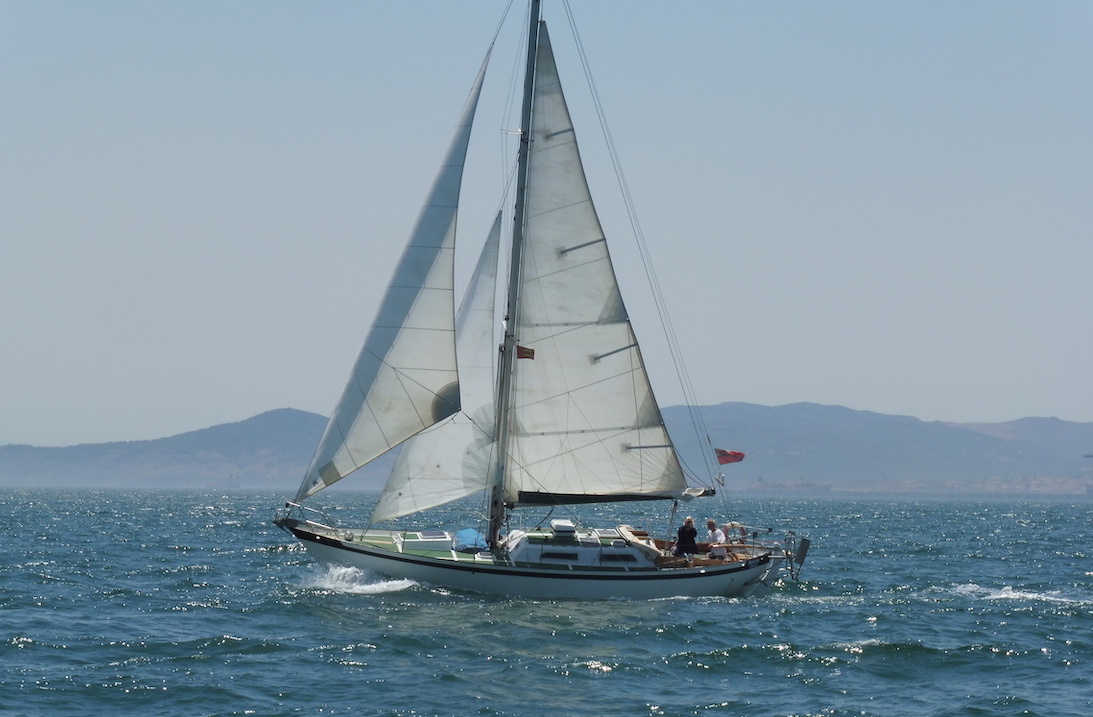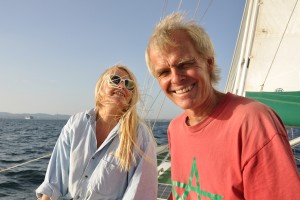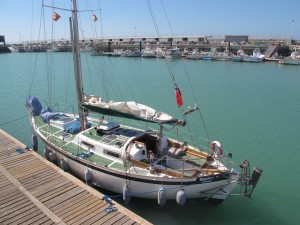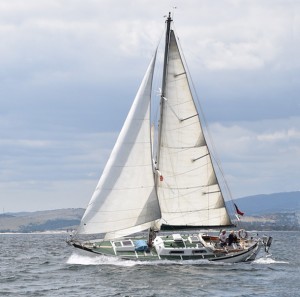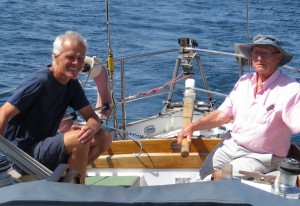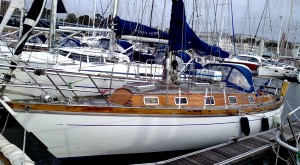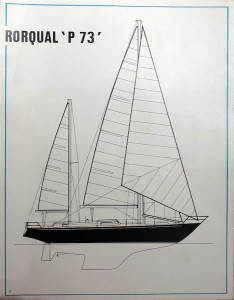Long term cruiser Richard Toyne on the process of choosing the boat to replace his beloved liveaboard ketch Sigfrid
When Magali and I decided to sell, our 34ft 6in (10.6m) steel ketch, and buy a fibreglass boat, we had a fairly clear idea of what we wanted. She should have a long keel, for an easy motion at sea. The coach-roof would be fairly short, finishing behind the mast, and ideally she would have a single masted rig although we were ready to consider another ketch. We also had a preference for a tiller rather than a wheel.
With these criteria in mind we started to look at the adverts for boats for sale. Among the first to catch our eye was the Tradewind 33. We had been onboard a Tradewind 35 and had seen a 39 from the quayside, both of which we considered, but felt that the 33 could be ideal. When fitted out in a traditional manner with a bowsprit they looked very appealing, and being only 33’ (10m) long we thought they should be fun to sail.
Other boats that caught our attention included the French built Chassiron yachts, both the 36ft (10.9m) RF and the 38ft (11.6m) GT, as well as the Saltram 40 or the 36. Finally there was the Rorqual NS44, another French built boat, which did not have a long keel but had a superb reputation for speed, seaworthiness and build quality.
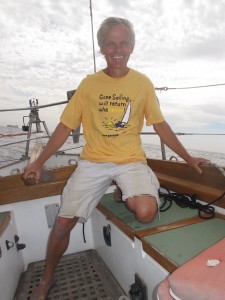
The first sail in Manina and I am wearing a T-shirt that sums up the benefits of a boat with less maintenance! © Magali Bellenger
For some time our hands were tied as we waited for a buyer for our house in England, and our enthusiasm would fluctuate between one design and another as boats came on to the market and were sold again. On one occasion we watched a double-ended cutter coming into the marina in Gibraltar, prompting Magali to comment “If this boat is built with a shorter coach-roof she could be ideal”.
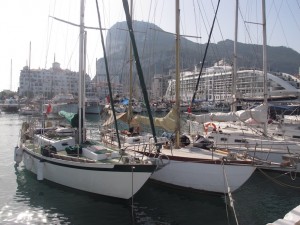
Sigfrid and Manina, still with her original name of Stromboli, moored side by side during the brief period when we owned both boats. © Magali Bellenger
The boat turned out to be Talisman one of the final Saltram 36 to be built and we discovered there was also a short coach-roof version. As so few had been built however they rarely appeared on the market, so we put the design to the back of our minds.
Finally a Tradewind 33 was advertised close enough to Gibraltar, where we were based, to be worth a visit. After spending several hours examining the boat we regretfully came to the conclusion that, although there were a lot of features we liked she was just that bit too small for us. Returning to Gibraltar we started to reconsider the Saltram 36, and found to our surprise that one was available within walking distance of where Sigfrid was berthed. This time we felt we had found the right boat and, to our delight, her owners were ready to hold her until the sale of our house completed.
Saltram yachts were designed by Alan Pape and built in three sizes; 40’ (12m), 36’ (10.9m) and 31’ (9.3m). They were all built in Plymouth by KR Skentelbery and Sons. The first one, a 40ft version, was conceived as a one off in 1978 and was constructed in GRP foam sandwich. As the hull took shape however it looked so good that it was used as a plug for a mould. Our boat, Manina, was constructed in 1988 and is hull number 4 of the 36’ model. Manina has a solidly built fibreglass hull stiffened by two stringers each side, glassed in frames and a solid fibreglass beam-shelf. The deck is epoxy sheathed plywood supported on laminated mahogany beams and she has an external cast iron ballast keel.
The interior follows a traditional layout with the galley to port and chart table to starboard as you come down the companionway ladder. Forward of this is the saloon with a drop-leaf table. Next come the heads and cupboards for storage and finally a V shaped berth in the bow. When we bought her there was a pilot berth to port in the saloon but this has now been converted to lockers and book-shelves. The interior was well planned out from new with easily accessible cable runs and an engine box that can be dismantled by undoing a few screws. When we first bought Manina we still owned Sigfrid, so we were able to try out our new boat before moving everything onboard.
We were impressed with her speed but found the motion surprisingly lively, particularly when working on the foredeck or down below. As we moved our belongings from one boat to another Sigfrid rose by in the water by two or three inches while Manina was weighed down by the same amount, so it was with a bit of trepidation that we took her sailing again. Thankfully she has benefitted from the extra weight. She has lost the bounciness she had when she was empty while still being lively fast and exciting to sail. She is light on the helm and easy to steer, even when over-pressed. At first this resulted in us leaving it rather late to reef but we have now learnt that if we reef in time she simply stands up, is more comfortable and gains speed. On one of our first trips back across the straits of Gibraltar, from Ceuta in North Africa, we logged over seven and a half knots close hauled in 20 to 25 knots of wind under the reefed mainsail, jib and staysail.
She has forged to windward at over six knots under a double reefed main, heavy weather staysail and a jib so small that we have nick-named it the “Petit mouchoir” (small handkerchief). Although I got totally drenched on the foredeck, as we shortened sail in the steep chop, she only threw the occasional dollop of spray as far aft as the cockpit. She has also ghosted along the Algarve coast of Portugal under cruising chute and mainsail, sailing over a blue sea barely bay of rippled by the wind, and she has achieved a top speed with us of 9.3 knots surfing back into the Bay of Gibraltar goose-winged under the single reefed main and yankee.
Perhaps one of our most memorable sails however occurred recently on a day of gentle breezes. John and Margaret Skentelbery, Manina’s builders were visiting Gibraltar. After being introduced and having a chat with them both on the pontoon John came on board for a trip around the bay, steering our boat with the tiller that he had crafted 30 years ago.
Main image (top), Manina at sea © Andrew Alcantara
Other boats that were on our short list
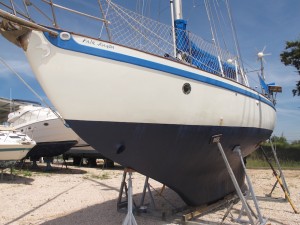
We were very keen on the Tradewind 33, but after visiting one decided they were a bit too small for us.
Tradewind 33: These boats had a lot of features that really appealed to us, a short coachroof often made of wood, tiller steering and a deep cosy looking interior. We were attracted by the size as we both tend to feel that in general small boats are more fun to sail, but decided in the end that they were that bit too small to make a satisfactory home for us.
Chassiron RF and GT: These French built long keeled cruising yachts have a good reputation both for build quality and performance. We found the tiller steered aft cockpit RF particularly appealing. With their wooden decks and high quality mahogany joinery work they have very attractive interiors.
Saltram 40: One of these could have been nice for the extra space below and extra storage, however our personal preference is for the
36; we already find Manina’s mainsail big enough to gybe in a fresh wind!
Rorqual NS44: This was the only design we seriously considered that did not have a long keel. Thought of as the ‘Rolls Royce’ of the French cruising yachts in the 1970s they are well built, spacious and fast. Although far bigger than we really needed the thought of slicing upwind or achieving speeds in double figures once we freed off was appealing!
Photos in this section: © Bruce Woodcock ipshome@me.com


